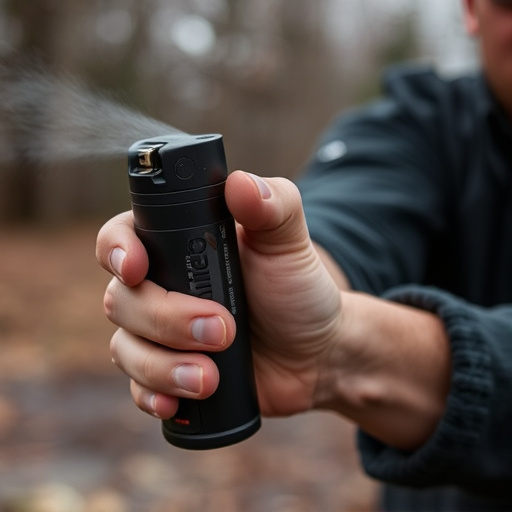The best bear spray application techniques focus on timing, distance, and proper targeting. Users should aim for eye protection, spraying from 20-30 feet away while moving, and follow product instructions for duration and bursts. Choosing the right bear spray based on region, potency, and weather conditions, combined with regular training, is crucial for effective deterrence. Techniques include checking can pressure, aiming at the bear’s face and eyes, maintaining a steady stream until retreat, and proper storage and compliance with local regulations to ensure safety in bear country.
Personal security is paramount when venturing into bear country. One powerful tool in your defense arsenal is bear spray, a non-lethal deterrent that can provide crucial time for escape during encounters with aggressive bears. This comprehensive guide explores the essential components of effective bear spray, from composition and effectiveness to choosing the right product for your needs and mastering best application techniques. We’ll also delve into safety precautions and post-encounter care, ensuring you’re prepared with the knowledge to use bear spray confidently in the wild.
- Understanding Bear Spray: Composition and Effectiveness
- Choosing the Right Bear Spray for Your Needs
- Mastering the Application Techniques: How to Use Bear Spray Effectively
- Safety Precautions and Post-Encounter Care
Understanding Bear Spray: Composition and Effectiveness
Bear spray, also known as bear deterrent or bear repellent, is a specialized product designed to protect individuals from potentially dangerous encounters with bears. Its primary composition often includes capsaicin, the same active ingredient found in chili peppers, combined with other chemicals to create a potent and safe solution for wildlife deterrence. The spray is effective due to its ability to irritate a bear’s eyes, nose, and respiratory system, causing them to retreat.
When considering the best bear spray application techniques, it’s crucial to understand that timing and distance are key. Users should aim for eye and face protection, as bears have excellent senses of smell and sight. Spraying from a distance of 20-30 feet (6-9 meters) while moving away is recommended. It’s also important to follow the product instructions regarding spray duration and the number of bursts allowed, as proper usage ensures maximum effectiveness without wasting the valuable defense resource.
Choosing the Right Bear Spray for Your Needs
When selecting a bear spray, it’s crucial to consider your specific needs and environment. Different regions have varying bear species and behaviors, so choose a spray designed for the types of bears you’re most likely to encounter. For example, black bear spray is effective against both black and grizzly bears, while more potent options are needed for grizzlies alone. Check labels for recommended range, potency, and ingredients—some sprays have higher concentrations of capsaicin, the active ingredient that deters bears.
Mastering the best bear spray application techniques is as important as having the right product. Always carry the spray in an easily accessible holster or pouch, and ensure you know how to deploy it quickly. The recommended technique involves aiming for the bear’s face, eyes, and nose at a range of 20-30 feet (6-9 meters). Practice makes perfect, so familiarize yourself with the spray’s nozzle and trigger before heading into potential bear country.
Mastering the Application Techniques: How to Use Bear Spray Effectively
Mastering the application techniques for bear spray is crucial for ensuring its effectiveness in real-world scenarios. The best bear spray application involves a few simple yet vital steps. First, ensure proper preparation by checking the spray can’s pressure level and confirming it’s within the recommended range. When faced with an attack, aim for the bear’s face and eyes—the spray irritates these sensitive areas, providing a crucial moment to escape. A quick burst at close range is ideal, but remember, consistency is key; maintain a steady stream until the bear retreats.
Practice makes perfect when it comes to mastering these techniques. Regular training sessions can help individuals become more comfortable and confident in handling bear spray during unexpected encounters. It’s also essential to choose the right type of bear spray for your specific needs, considering factors like range, concentration, and weather conditions, ensuring you’re prepared for any potential inflammatory defense scenario.
Safety Precautions and Post-Encounter Care
When using bear spray, safety precautions are paramount. Always check local regulations and ensure you have the appropriate license to carry and use it. Before an encounter, familiarize yourself with the product’s active ingredients, range, and wind conditions. Proper storage is also crucial; keep it out of reach of children and pets, in a cool, dry place. During an encounter, follow the best bear spray application techniques: aim low, towards the bear’s face and sides, and spray in short bursts. Keep moving to increase the spray’s effectiveness and prevent close contact.
Post-encounter care is just as important. If a bear charges, do not run, as it may trigger their predatory instincts. Play dead if attacked, protecting your vital organs. After the bear has left, quickly assess any injuries and seek immediate medical attention. Clean and bandage wounds thoroughly to prevent infection. Remember, proper training and understanding of bear behavior can significantly enhance your safety in the wild.
When it comes to personal security in wild environments, understanding and mastering the best bear spray application techniques is essential. By choosing the right product tailored to your specific needs and following safety precautions, you can significantly reduce risks during encounters with bears. Remember, proper usage of bear spray isn’t just about carrying a defense mechanism; it’s about knowing how to deploy it effectively for maximum protection. With the right knowledge and preparation, you can ensure a safer outdoor experience in bear country.
